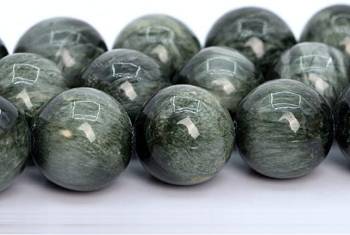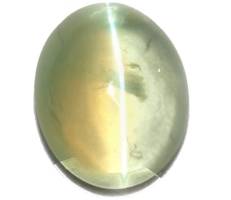Embark on a journey into the captivating world of chatoyancy, a rare optical phenomenon in which gemstones unveil a mesmerizing cat’s eye glow. This journey unravels the magic behind the unique shimmer, enthralling enthusiasts and collectors with its rarity and beauty.
Table Of Contents
- 1) What Is Chatoyancy, And How Is It Manifested In Gemstones?
- 2) The Science Behind The Cat’s Eye Effect
- 3) Crafting And Evaluating Chatoyant Gems
- 4) Full Spectrum Of Chatoyant Gemstones
- 5) The “Milk And Honey” Effect In Chatoyant Gemstones
- 6) Comparing Chatoyancy With Other Optical Phenomena
- 7) Related Topics And Further Exploration
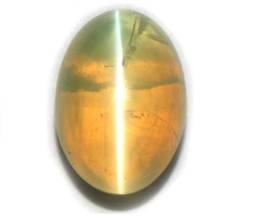
2.34 Carats Chrysoberyl Cat’s Eye |
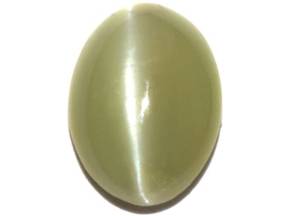
Chrysoberyl Cat’s Eye 1.60 Carats |
|
|
1) What Is Chatoyancy, And How Is It Manifested In Gemstones?Back To Top |
Chatoyancy is a rare optical phenomenon in the world of gemstones. The spectacle is renowned for its captivating cat’s eye effect. This unique visual miracle results from light reflecting off parallel inclusions within the stone. The synchronized reflection creates a luminous band that glides as the angle of light changes. The beauty of chatoyancy lies in its dynamic display, reminiscent of a cat’s pupil narrowing and widening.
|
|
1.a) The Meaning Behind The Word “Chatoyancy”Back To Top |
The word “chatoyancy” comes from the French verb “chatoyer,” which means “to shine like a cat’s eye.” It’s the perfect description for this optical effect, where a bright, moving band of light glides across the surface of a gemstone. This shimmering line is often called the cat’s-eye effect, and it’s what defines chatoyant gemstones. When viewed under changing light or from different angles, these gems display a dynamic glow that continues to fascinate gem enthusiasts and collectors. It’s this movement of light — not just surface shine — that makes chatoyancy so special.
|
|
2) The Science Behind The Cat’s Eye EffectBack To Top |
The core of chatoyancy lies in its internal structure. In gemstones like chrysoberyl, the presence of rutile, composed mainly of titanium dioxide, plays a crucial role. These rutile inclusions align perpendicularly within the gemstone, catching and reflecting light to produce a distinct cat’s eye appearance. This alignment is critical, as it must match the gemstone’s crystal structure to create the desired effect.
|
|
2.a) A Simple Analogy: Silk Thread And ChatoyancyBack To Top |
Chatoyancy Like Cat’s-Eye On Spools Of Thread |
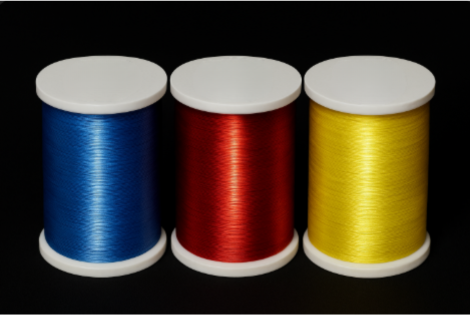
|
An easy way to picture chatoyancy is to think of a spool of fine silk thread under a focused light. As the light hits the smooth, parallel threads, it creates a bright band that seems to glide as you move the spool. Chatoyant gemstones behave in much the same way — the parallel inclusions inside the gem reflect light to produce a moving, eye-like band. This simple analogy helps explain why chatoyant gems display such a captivating and dynamic optical effect.
|
|
2.b) Why The Cat’s Eye MovesBack To Top |
When you tilt a chatoyant gemstone or shift the light source, the bright band of light appears to glide across the stone’s surface. This movement happens because the light reflects off the parallel inclusions inside the gem. As the viewing angle or lighting changes, the position of the reflected light band shifts too. This dynamic motion is what gives chatoyant gems their lively, almost hypnotic quality — a key reason why collectors and jewelry lovers find them so fascinating.
|
|
3) Crafting And Evaluating Chatoyant GemsBack To Top |
Crafting a gemstone to reveal its best chatoyancy is both an art and a science. Lapidaries must carefully orient and cut each stone to maximize the visibility of its cat’s eye effect. Evaluating these gems also takes a trained eye — factors like sharpness, movement, and contrast all play a role in determining quality.
|
|
3.a) Capturing Chatoyancy: The Role Of Gemstone CuttingBack To Top |
To fully reveal chatoyancy, the gemstone must be shaped with great care. The cabochon cut — with its rounded top and flat base — is the best choice for bringing out the moving band of light that defines a fine cat’s eye gem.
Achieving the perfect cat’s eye effect is a testament to the precision and skill of lapidaries. Gemstones are typically cut into a cabochon shape, featuring a rounded, flat base that enhances the interaction between light and the internal fibrous structures. High-quality specimens exhibit a sharply defined band of light that glides across the stone when viewed from different angles. On the other hand, lower-quality stones may display a less distinct or banded effect.
|
|
3.b) How Lapidaries Evaluate The Quality Of A Cat’s Eye GemstoneBack To Top |
When evaluating a cat’s eye gemstone, experts look for several key traits. The ideal stone displays a sharp, well-defined band of light that moves smoothly across the surface. Symmetry is also important — the cat’s eye should run straight and be centered when viewed from the top. Strong contrast between the bright band and the body color adds depth and drama. Finally, the stone’s clarity, color, and polish all contribute to the overall beauty and value of a chatoyant gem.
|
|
3.c) When Diffraction Adds Spectral Colors To Chatoyant GemsBack To Top |
In some rare chatoyant gems, you might also see flashes of spectral colors — an effect caused by diffraction. This happens when the inclusions inside the stone are coarse or spaced just right to split light into its component colors. The result is a shimmering play of rainbow hues that can appear alongside the cat’s eye band. Though not common, this added layer of visual interest makes such gems especially prized by collectors.
|
|
3.d) Expert Tips For Buying Chatoyant GemstonesBack To Top |
When buying a chatoyant gemstone, start by looking for a sharp, centered cat’s eye that moves cleanly as the stone is tilted. The eye should stand out clearly against the body color, with strong contrast. Symmetry matters — avoid stones where the eye appears off-center or uneven. Also check for good polish, few visible inclusions, and even color. Finally, ask whether the stone is natural or treated, and buy from a trusted seller who can provide details about its origin and cutting.
|
|
4) Full Spectrum Of Chatoyant GemstonesBack To Top |
While chrysoberyl and tiger’s eye are the most famous chatoyant gems, many other stones can display this striking optical effect. Some are well-known classics, while others are rare surprises for collectors. The following sections explore both familiar and lesser-known examples of chatoyant gemstones.
Gems Exhibiting A Single Bright Band Are Called Cat’s Eyes
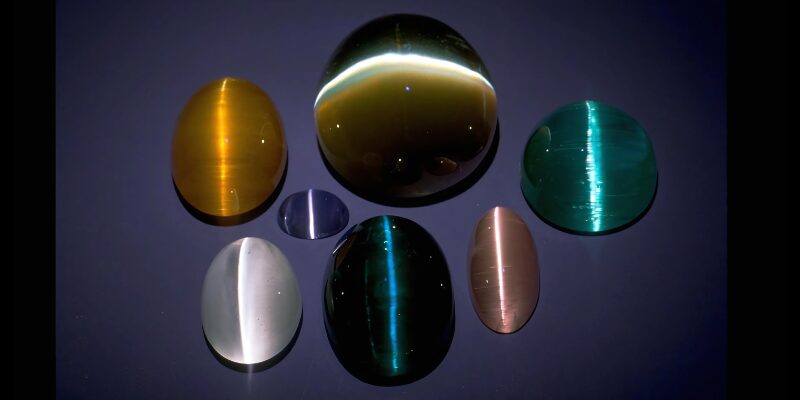
Image source: https://naturalhistory.si.edu/explore/collections/geogallery/10025988
|
|
4.a) Classic Cat’s Eye GemstonesBack To Top |
We can see this enchanting attribute in a variety of gems, from the well-known tiger’s eye to the luxurious chrysoberyl cat’s eye
Several gemstones are famous for displaying strong chatoyancy. At the top of the list is chrysoberyl cat’s eye, prized for its sharp, bright band and high contrast. Tiger’s eye quartz is another well-loved example, with its golden shimmer and silky appearance. Other classic chatoyant gems include cat’s eye tourmaline, actinolite, apatite, scapolite, and beryl varieties such as aquamarine and emerald. These stones consistently attract collectors and jewelry designers looking to showcase the cat’s eye effect.
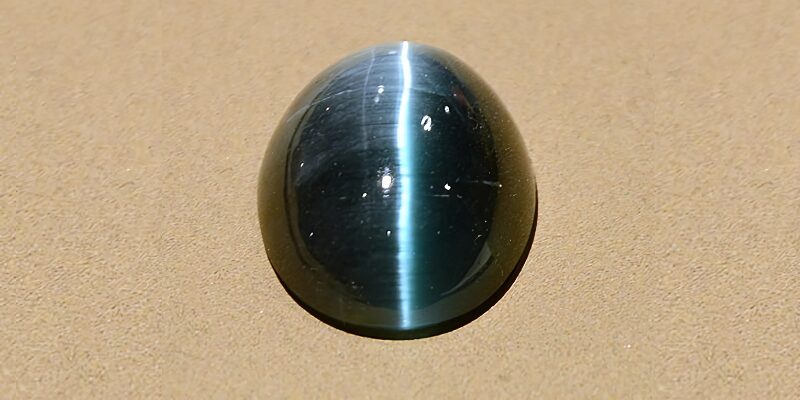
Image source: Vassil, Public Domain (CC0), via Wikimedia Commons.
Chrysoberyl Cat’s Eye: The Pinnacle Of Chatoyancy
Chrysoberyl Cat’s Eye, revered for its captivating beauty, is a premier example of chatoyancy. This gemstone mesmerizes with a sharp, silken band of light that gracefully moves across its surface, mimicking the narrow pupil of a cat’s eye. Unique among chatoyants, Chrysoberyl Cat’s Eye owes its striking effect to tightly packed, parallel inclusions of rutile or silk. The precision in cutting this gem into a cabochon shape, with the dome aligned perfectly with the inclusions, accentuates its chatoyancy, making it a prized possession in the gem world.
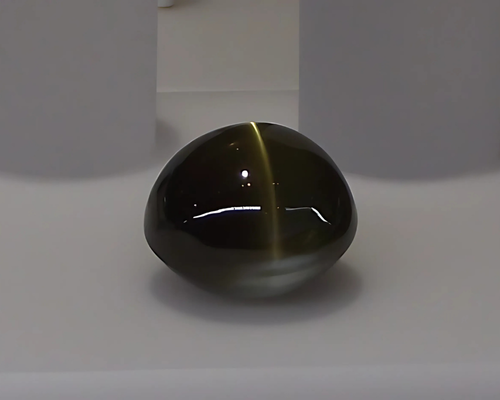
Image source: Stickpen, Public Domain, via Wikimedia Commons.
Tiger’s Eye: Earthy And Alluring Chatoyancy
Tiger’s Eye, another classic chatoyant gemstone, offers a different allure. Originating from the transformation of crocidolite, a form of asbestos, into quartz, this metamorphic rock showcases an earthy blend of golden to red-brown hues. Its chatoyancy emerges from the fibrous structure of the crocidolite, preserved within the quartz, creating a captivating play of light. Unlike the focused band seen in Chrysoberyl Cat’s Eye, Tiger’s Eye displays a broader, more diffuse luminescence akin to the shifting light of the sun.
Comparing Their Beauty And Value
While both Chrysoberyl Cat’s Eye and Tiger’s Eye showcase the enchanting effect of chatoyancy, their appeal and value differ significantly. With its sharper, more defined cat’s eye, the Chrysoberyl Cat’s eye effect commands higher prestige and price. We use it in jewelry. On the other hand, Tiger’s Eye is beloved for its unique coloration and broader appeal, making it a popular choice for various decorative items. Together, these gemstones illustrate the diverse beauty of chatoyant gems, each offering a unique window into the dynamic interplay of light and mineral.
|
|
4.b) Lesser-Known And Rare Chatoyant GemstonesBack To Top |
Chatoyancy isn’t limited to just the well-known stones. Many lesser-known gems can also show this optical effect when cut properly. Examples include sillimanite, kyanite, garnet, spinel, zircon, prehnite, enstatite, diopside, danburite, and iolite. These rarer chatoyant gems can surprise collectors with unique colors and subtle variations of the cat’s eye effect. Because they are less common in the market, they offer an exciting option for those seeking unusual pieces.
Tourmaline: Chatoyancy In A Rainbow Of Colors
Tourmaline, a gemstone celebrated for its extensive color range, also showcases the chatoyant effect, particularly in its cat’s-eye varieties. The chatoyancy in tourmaline results from light reflecting off parallel inclusions within the gem, creating a captivating eye effect that enhances its appeal. The quality of this effect is determined by the clarity of the visible eye and the stone’s body color, making each piece unique. The cutting technique, aiming to align the inclusions parallel to the cabochon’s base, is crucial in maximizing the chatoyant display.
Moonstone: Subtle Cat’s Eye Glow
Moonstone, known for its adularescence, occasionally exhibits chatoyancy, adding to its mystical allure. The phenomenon in moonstone creates a serene, glowing line across the stone that shifts with the light, contributing to its reputation for romance and mystique. The effect is more subtle than the stark bands in other gemstones. Still, it adds depth and interest to the captivating moonstone.
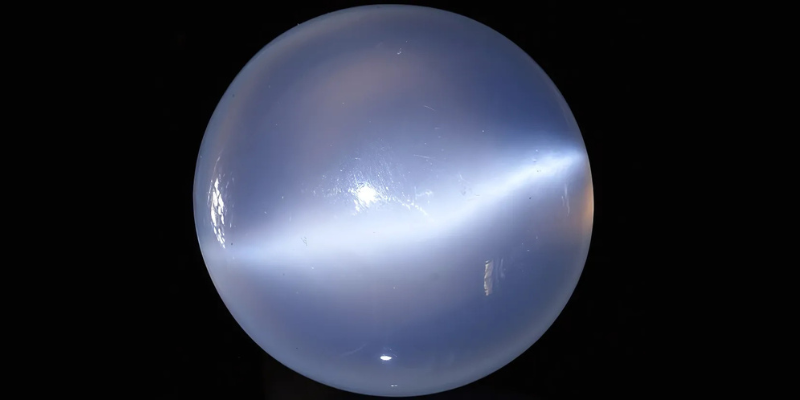
Sapphire: Rare And Delicate Chatoyancy
Sapphire, a corundum variety, is more commonly associated with asterism but can also display chatoyancy under rare circumstances. This effect in sapphire is not typically caused by the solid inclusions found in other chatoyant gems but rather by internal parallel fracture surfaces and fluid inclusions. Through these natural features, the intricate play of light provides a subtle yet remarkable cat’s eye effect. The orientation and cutting of the gemstone are critical to showcasing this phenomenon, revealing the skill and precision required to bring out the chatoyant band in sapphires.
In exploring the unique displays of chatoyancy in tourmaline, moonstone, and sapphire, we uncover how light and internal gemstone structures interact to produce this enchanting effect. Each gem offers a distinct version of chatoyancy, from the pronounced and sharp eye of tourmaline to the gentle glow of moonstone and the rare, refined band in sapphire. This diversity highlights the beauty and complexity of chatoyant gemstones. It underscores the importance of expert cutting to reveal their full potential.
Chatoyant Quartz: Rare Cat’s Eye Effects
Quartz, one of the most versatile minerals, sometimes exhibits chatoyancy, creating stunning visual effects. This optical phenomenon, often compared to a cat’s eye, arises from light reflecting off parallel inclusions within the stone. The classic examples of chatoyant quartz include varieties such as tiger’s eye, hawk’s eye, and bull’s eye, each distinguished by fibrous inclusions that give rise to its mesmerizing glow. These inclusions, acting like a series of parallel needles, generate a moving reflection band that captures the essence of chatoyancy.
Apatite: Uncommon But Beautiful Chatoyancy
Apatite, a lesser-known gemstone that can also display chatoyancy, is coveted for its vivid colors and unique optical qualities. The chatoyant effect in apatite is not as commonly encountered as in other gemstones, making specimens with a clear, visible cat’s eye highly prized. Similar to other chatoyant gems, the effect in apatite is caused by the reflection of light off internal parallel growth channels or needle-like inclusions. This effect can make apatite, especially those with colors akin to chrysoberyl cat’s eye, highly sought after by collectors and jewelry designers. Properly cutting and polishing apatite are crucial to reveal its chatoyancy, enhancing its beauty and appeal.
|
|
4.c) Synthetic Chatoyant Materials And Glass ImitationsBack To Top |
Not all chatoyant stones are natural. Some synthetic materials and glass imitations are crafted to mimic the cat’s eye effect. These can be attractive and affordable, but they lack the rarity and value of genuine chatoyant gemstones. Common imitation materials include fiber-optic glass and lab-created quartz. When buying, it’s wise to ask about a gem’s origin and whether it is natural or synthetic, especially for high-end jewelry.
Glass Imitations: A Note of Caution:
While natural chatoyant gems are treasured, the market also includes glass imitations designed to mimic this effect. These imitations, made from colored fiber optic glass, can be easily identified by examining the side view of the cabochons, revealing the artificial fibers responsible for their chatoyancy. Awareness and careful examination are essential when purchasing chatoyant gemstones to ensure authenticity.
|
|
5) The “Milk And Honey” Effect In Chatoyant GemstonesBack To Top |
Several gemstones can display the milk and honey effect when conditions are just right. This optical effect is most often seen in the following types of chatoyant gems (seen in Para 5.b. below), though the intensity of the phenomenon can vary from stone to stone.
|
|
5.a) Understanding The Unique “Milk And Honey” Effect In Chatoyant StonesBack To Top |
The “Milk and Honey” effect in chatoyant gemstones is a striking optical phenomenon that presents a sharp contrast of light and dark hues within the stone, reminiscent of its namesake. This effect is particularly pronounced under direct light, showcasing a vivid division that enhances the gem’s allure and perceived depth. It’s a hallmark of high-quality chatoyancy.
Deciphering the Dual Visual Impact: Light and Color Play in “Milk and Honey:”
The “Milk and Honey” effect in chatoyant stones like Chrysoberyl cat’s eye offers a captivating dual visual impact, blending light and color. This phenomenon occurs when light is directed towards the stone, causing one-half to illuminate with a rich honey color. In contrast, the other half displays a softer, milky appearance. Concentrated light sources make this striking contrast more pronounced with the chatoyant band positioned at right angles to the light. It showcases the stone’s intrinsic beauty and depth.
This unique effect not only underscores the rarity and appeal of the Chrysoberyl cat’s eye but also highlights the gem’s exceptional quality when the honey and milky zones are sharply defined. Skillful cutting and polishing are crucial to enhancing this effect.
|
|
5.b) Examples Of Gemstones Exhibiting The “Milk And Honey” PhenomenonBack To Top |
The “Milk and Honey” effect is a remarkable phenomenon observed in chatoyant gemstones, offering a striking visual contrast. This section explores gemstones known for exhibiting this captivating feature.
Chrysoberyl Cat’s Eye: The Quintessence of Milk and Honey:
Chrysoberyl Cat’s Eye is perhaps the most famous bearer of the “Milk and Honey” effect. The effect is so pronounced and sought after in this gem that when light hits the stone, one side glows with a golden honey color while the other appears milky white. The clear demarcation and the sharp eye movement as the stone is rotated make Chrysoberyl Cat’s Eye a top-tier example of this phenomenon.
Tiger’s Eye: Earthy Interpretation:
While Tiger’s Eye primarily showcases chatoyancy, certain high-quality pieces can exhibit a version of the “Milk and Honey” effect. The effect is more subdued in these stones, with the fibrous structure creating an earthy, banded appearance that shifts in the light. The silky luster and rich brown and golden hues can mimic the “Milk and Honey” appearance under specific lighting conditions.
Apatite: A Rare Vision:
Apatite, especially in its rare cat’s eye variety, can display a “Milk and Honey” effect, though this is less common. The phenomenon in Apatite is typically more subtle than Chrysoberyl but adds depth and interest to this already intriguing gemstone. The contrast between Apatite’s milk and honey colors enhances its visual appeal and rarity.
Quartz Varieties: Broad Spectrum Display:
Certain varieties of Quartz, including Hawk’s Eye and some forms of Cat’s Eye Quartz, can show a diffused “Milk and Honey” effect. The variability in the inclusions and the size of the Quartz pieces mean that the effect can range from stark and noticeable to subtle and nuanced, offering a broad spectrum of appearances within the same mineral family.
10MM Genuine Natural Green Chrysoberyl Cat Eye Beads (chatoyancy)
2.30 Carats Chrysoberyl Cat’s Eye
|
|
6) Comparing Chatoyancy With Other Optical PhenomenaBack To Top |
Chatoyancy is one of several fascinating optical effects seen in gemstones. It is often compared with phenomena like asterism and the Alexandrite effect — but each has its own cause and appearance. Let’s explore how these effects differ.
|
|
6.a) Comparing Chatoyancy With Asterism And Alexandrite EffectBack To Top |
While chatoyancy appears as a single moving band of light, asterism creates a star-like pattern, usually with four or six rays, caused by intersecting inclusions. In contrast, the Alexandrite effect is not a reflection phenomenon — it is a dramatic color change caused by the gem’s selective absorption of different wavelengths under various lighting conditions. Though all three effects captivate the eye, each arises from distinct physical causes inside the gemstone.
|
|
6.b) Other Related Optical EffectsBack To Top |
Other gemstone optical effects worth exploring include adularescence (the soft glow in moonstone), labradorescence (the colorful flash in labradorite), and the Schiller effect (a metallic sheen in stones like sunstone). Each of these creates its own form of visual magic, distinct from chatoyancy.
|
|
7) Related Topics And Further ExplorationBack To Top |
Collectors often explore related gemstone effects beyond chatoyancy, such as star-like patterns, glowing sheen, and shimmering color play. Each optical phenomenon offers a different view into the dynamic relationship between light and gem material. Visit the pages shown below to explore related gemstone effects.
| Explore Asterism in Star Gemstones | Adularescence & Labradorescence: Glow and Color Play in Gems |
| Gemstone Fluorescence | Phenomenal Gemstones |
